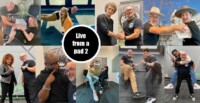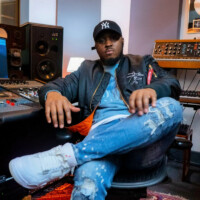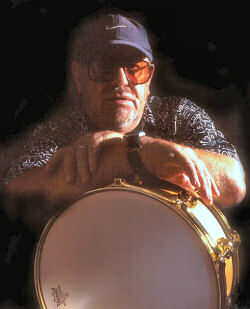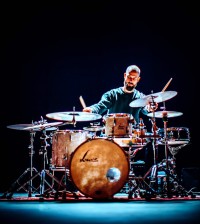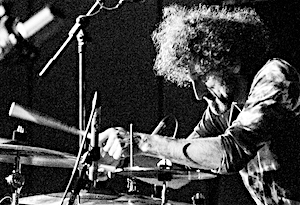 Its been a few years since I last had the chance to sit down and do an interview with Gavin. He has finally found time to record an album he’s been planning for a very long time which is something a little different. If you are already a Porcupine Tree fan you might already recognise most of the tunes, but they have been treated to some great, and different, arrangements by UK bass player Laurence Cottle, feature superb production and a 5.1 surround sound mix, all of which I was lucky enough to experience in Gavin’s studio.
Its been a few years since I last had the chance to sit down and do an interview with Gavin. He has finally found time to record an album he’s been planning for a very long time which is something a little different. If you are already a Porcupine Tree fan you might already recognise most of the tunes, but they have been treated to some great, and different, arrangements by UK bass player Laurence Cottle, feature superb production and a 5.1 surround sound mix, all of which I was lucky enough to experience in Gavin’s studio.
We also got a chance to talk about the three-drummer King Crimson gig which is coming to the UK soon.
We haven’t spoken for a while so there’s a few things we need to talk about; first up the new album, the big band album I guess we could call it. It’s something you’ve been talking about for a while and I know Laurence Cottle has done some arrangements for you, what can we expect?
When people say ‘big band’ it can conjure up all sorts of memories of music from a long time ago. I love big band music and I grew up with it, but I can see that for some audiences, big band is not something they’re particularly familiar with and if you say “Hey I’m doing a big band album” that might worry some people.
The first song I did with Laurence was actually an arrangement I was meant to play with the Buddy Rich Big Band in 2009 in Las Vegas, a concert that didn’t actually happen, as it got cancelled. The organisers asked me if, as well as playing a couple of Buddy Rich pieces, I could play one of the Porcupine Tree songs. So I chose the heaviest song that PT ever wrote called “Futile” and I really wanted to work with Laurence on an completely new arrangement of it.
It was never intended to be humorous. It’s features a modern approach to brass arranging, much more like a film score in that it goes beyond the normal scope of instruments that you would have in a big band (typically four trombones, five saxes, four trumpets). So on this record we’ve also used tuba, euphonium, flutes, tenor horns, clarinets and tubax (which is a double bass sax). There’s orchestral percussion on there and I played a lot of parts on my marimba. There are no keyboards or guitar in there so all the chords are carried by the brass section, which is lovely!
I’ve always enjoyed hearing thirteen brass players blast out a chord, it’s so much nicer than hearing the same chord played on a piano because each note has a life of it’s own. Anyone who’s listened to big band or been lucky enough to play in a big band knows how exciting that sound is! It’s a sound that I got as a young kid from my dad, going to see big bands play and sitting in the middle of the BBC big band with their drummer Paul Brodie. That really just knocked me out when I was eight years old, I fell in love with it.
How did you pick the songs to play?
Most of the songs started with me sitting at the drums, thinking “How could I come up with a new approach? I need a good plan for this song”. Most times I would sing the song to myself whilst improvising on the drums trying to find a new and and hopefully interesting path. Later on, once I’d settled on a rhythmic idea, I’d record myself singing some of the bass lines and riffs along with this new drum rhythm and start figuring out how the melody could gracefully integrate with the new approach.
Luckily you’ll never ever hear any of those recordings of me singing, but it was a way that I could present it to Laurence and get my basic ideas across to him. So it was really sketchy!
Did you approach how you play the drums differently this time?
I don’t think so. Although people haven’t really heard me playing much jazz, it’s actually what I grew up listening to and playing. I wondered if I should go for a classic jazz drums sound, do I need a big bass drum with two heads ringing, do I need a 12” tom and a 16” tom? That’s all great but it’s not my voice.
I think I have, over the years, refined my sound and it comes from the way I hit them and tune them, with the heads, cymbals and sticks that I choose to go with them.
I felt that I’d rather be myself than do a really half baked Buddy Rich impression. I just do it from my point of view, that’s the way I hear it. It wasn’t meant to be a tribute or a pastiche.
 What I noticed wasn’t so much about the sound but the melody you had coming off the toms, the comping sound. Did you purposefully go “Right, this is how I recorded it with Porcupine Tree, now I’ve got to approach it in a different format…”?
What I noticed wasn’t so much about the sound but the melody you had coming off the toms, the comping sound. Did you purposefully go “Right, this is how I recorded it with Porcupine Tree, now I’ve got to approach it in a different format…”?
Yes! There was no point trying to play it exactly how I did with Porcupine Tree, but instead of Steve’s voice we’ll have a clarinet and instead of Richards’ keyboards we’ll have a trombone. These really are not cover versions.
This had to be completely re-imagined and of course, working with one of the best arrangers I know, Laurence Cottle, I knew whatever I threw at him he would come up with something musically great.
A lot of the time we just discussed policy, where we wanted to go and also where we didn’t want to go with it. We discussed arrangers that we liked, Frank Zappa and Don Ellis, Pat Williams, Gil Evans, Vince Mendoza, along with a lot of classical composers that Laurence really likes and there are little quotes in there if you know the stuff, there’s Prokofiev and Stravinsky and little bits of Bob Brookmeyer, Tower Of Power, Earth Wind and Fire, Stan Kenton, Steve Reich and lots of others. A couple of friends that I’ve played the album to said: “Wow yeah, I got that bit”.
There are also a few little drumming quotes. There’s one song that I start playing the floor tom in a Gene Krupa “Sing Sing Sing” kind of way, which is an obvious nod to him! He was really the first drummer to bring the drums to the front of the music, it was the beginning of the modern drum set and we owe a lot to Gene for that. Before that, drums were pretty much a dull thud in the background. Drums were not a featured instrument, they were not a lead instrument and from Gene Krupa grew the modern way of drumming and through Buddy Rich and all the jazz drummers, the funk drummers and the rock drummers it all came along in a beautiful historic path. There’s one moment where I play single stroke roll for four bars, like the Buddy Rich break in “Love for Sale”. I found a little moment in “The Pills I’m Taking” that was just right for it. For those out there who know it, they might recognise it.
With accents?
Oh no, dead straight and it nearly killed me! Luckily for me I got to play “Love for Sale” with the Buddy Rich Orchestra in 2012 at the London Palladium.
I don’t want to divert from the album too much but I think that’s something a lot of younger drummers don’t understand about Buddy; he had amazing chops and when you look at the equipment they had back then he really did have amazing chops, speed etc.
Oh yeah!
I know you recorded the drums in your studio and the band in Laurence’s studio explain how you recorded the band?
Well it’s a quite modern way of recording something like this. We recorded every single instrument, one at a time. Firstly Nigel Hitchcock, played all five saxes on each song. Then we’d get a trombone player (usually Mark Nightingale) to track all the trombone parts and then a trumpet player to do the same and so on. That presents quite a difficulty in doing it one at a time, the players have to be extraordinarily good in their pitching and their timing, but you do get a nice timing feel when it’s the same person playing all five sax parts for instance.
The difficulties are trying to avoid phasing. If there’s a part where Nigel is playing say lead alto and he’s playing the same note on the second alto part, those two notes together played by the same guy on the same instrument down the same mic; that’s when you might hear phasing.
So whenever there was a unison note on the same instrument (like two tenors, or two altos etc.) we did it with a different microphone facing in a different direction in the room.
 I didn’t know if you’d done it at Abbey Road or one of the big rooms.
I didn’t know if you’d done it at Abbey Road or one of the big rooms.
I’m glad you thought that. I’d love to say I did but you can imagine the kind of budget you would need to go down to Abbey Road Studios with an eighteen piece big band. These arrangements are really hard and I think we’d have struggled to get even one song down in a day!
That brings me onto my next question; a lot of guys are now looking to record albums or DVD’s using for example Kick-Starter. How do you A/ make that album become profitable, if you do and B/ why?
Well, from my perspective it’s just something I’ve always wanted to do, I paid for the whole album out of my savings and I don’t expect I’ll ever hit a profit. Even in this modern way of recording, it was still relatively expensive to me.
I could go on a world cruise, go swimming with dolphins and do some bungee jumping; but what I would rather do is spend it on an album like this, it’s the sort of ‘bucket list’ thing to do. This is the sort of record that when I’m 95 years old sitting in an old people’s home, I’ll look back and think “That was one of the best things I ever did”.
That’s why I did it, there was something inside me that really wanted to do it and so I’m happy to spend my money on it.
I didn’t feel I wanted to do a Kick-Starter or Pledge crowd funding thing and with the complexity of this project; taking about six to nine months to get one song done, arranged to the way we liked it, getting the guys in one at a time and torturing them to get this stuff recorded to such a high standard. If I had done a crowd funding thing, I don’t think people would be happy to fund it and then wait five years. Plus I wanted to do it at my own pace without any pressure!
Obviously Laurence is a busy musician and I’ve been pretty busy too so it wasn’t like we worked five years continuously, we probably worked about a month continuously on each tune, but those thirty days were dragged out over six to nine months.
The guys on this album make up the British big band scene.
Yes they do. So apart from the guys I’ve already mentioned there was Adrian Hallowell, John Barclay, Tom Walsh, Ryan Quigley, Freddie Gravita, Pete Long, Ben Castle, Gareth Lockrane, Andy Findon. My old friend Dave Stewart played orchestral percussion, Laurence plays bass of course and I got Larry Williams to play flute solo on the first song. Larry was part of maybe the most famous modern brass section called “Seawind Horns” who played on Michael Jackson, Chaka Khan, Boz Scaggs albums (to name but a few) and so I was extremely pleased that he agreed to play on it. My dear friend Gary Sanctuary plays the only piano solo on the whole record.
You’ve recorded the album in 5:1 Surround Sound, and chance being most people aren’t going to listen to it like that, but even in stereo you’re going to hear it’s clean and clear!
Oh yeah, most modern records are made this way. All I can tell you is that everything you’re hearing is real stuff, there is no midi going on, it’s all real players which is fantastic and is something that really stands out when you hear the quality of the players.
 Let’s talk Porcupine Tree, I’m sure a lot of people are wondering when, if, how; what is the current situation?
Let’s talk Porcupine Tree, I’m sure a lot of people are wondering when, if, how; what is the current situation?
After the last tour we said “We need to take a big break” because we toured a little too much on the last tour, we did about fourteen months and then the break just got bigger and bigger. We all got involved in different things, Steve wanted to do his solo project and I got in involved in King Crimson and various other projects, as have Richard and Colin and the time hasn’t come round to the point where we think “Let’s do it now”. All I can tell you is that we haven’t split up.
Lets talk about King Crimson…
We’ll be doing a UK tour which I believe King Crimson haven’t done in a very long time, decades in fact! They’ve played in London many times but they haven’t gone around to many of the other major cities so there is a fairly extensive tour of the UK and a couple of other gigs in mainland Europe, that being Paris and Utrecht. After that I’m hoping there will be some more shows in other parts of the world.
How was it working with three drummers?
It’s great! It’s always nice to be faced with an interesting challenge; there is nothing worse than just doing the same thing over and over in whatever you do, even if you don’t work in music. It’s not stimulating to just keep doing the same stuff all the time and when people present you with challenges you can see opportunities with three drummers, that’s quite a mind blowing prospect!
Again we needed to set policies and concept ideas, so I sat and talked to Pat (Mastelotto) and Bill (Rieflin) on the phone; Bill lives in Seattle and Pat in Austin Texas, so we’d get on Skype with each other and say “We don’t want to all play the same thing do we?”.
So how can we approach it? Well one way could be to think of the three drum sets as one big drum machine and one of us be the guy who writes the arrangement, like “Ok, you play this on the hi hat, you play the toms and I’ll play the snare drum, bass drum and ride cymbal, but we’re all going to play like jigsaw pieces, we’re not just all going to play on top of each other”.
Another way is think more from a sonic point of view, sometimes we all play electronics. Sometimes we displace against each other, so one of us goes a 16th note early and another goes an 8th note late and one guy stays on the beat. Then we switch and we move it all around in all the different parameters we can think of! There are all kinds of tricks you can think of when you put your brain into ‘creative mode’. It’s true of a lot of creative people, they’re very good at solving problems, whatever you’re working on. If you’re a good teacher you find solutions for certain pupils that only apply to that pupil. Sometimes you find good solutions for yourself!
Even though I had lessons as a kid, I think most of the learning was actually on my own. It’s something that every student should experience, the absolute joy of discovering things that are new to you and have that feeling of “Wow, I’ve invented this”, even if it turns out later that other people have done it before.
That’s brilliant, that’s so much nicer than being shown something and you’ve just copied it. When you actually come up with something on your own you learn it in such a deep way, so it’s important to find creative solutions.
 Did the creative solutions come in rehearsals at the beginning or did it grow as the tour went on?
Did the creative solutions come in rehearsals at the beginning or did it grow as the tour went on?
It started off with the three drummers in my studio before we got together with the band and we had a few multi-tracks that we could play to.
We would play, record, listen and consider. Then one of us might say “I tell you what, you play the bass drum, and I’ll lay off the bass drum, I’ll do the hi hat and snare drum and then we all play together on the toms” – then we’d rehearse that just see what worked.
Other times there were bits where one of us would actually pre-arrange what we were going to do, that would still evolve a little bit and other times we would just start to play and see what happened.
Is it hard working with three drummers?
It’s hard to listen to two other drummers as you’re playing. You have to be really aware of what they’re doing and not improvise too much on the parts because otherwise you’re going to ruin the arrangement.
There are a lot of moments in a King Crimson show where you can improvise and there are moments where every player gets their chance to do that.
There are other things that aren’t written note for note but more in an ethereal way like “This is the vibe we’re going to do in this eight bars; and Pat’s going to play metallic noises”. But that’s all he’s got to know he doesn’t need to remember the pattern or the sticking he just knows “Oh I’m doing metallic percussion in those eight bars” and it will be different every night because it’s not written, then Bill’s going to play the toms in those bars and I’ll do something else.
Some nice things can happen by accident, and it’s interesting to think beyond yourself as the only rhythm provider.
Whose idea was it to put three drummers together in the first place?
It came from Robert Fripp
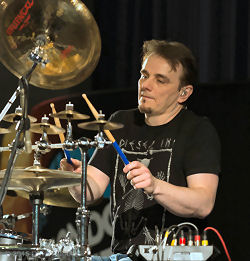 And when you were approached to be a part of that team, how did they sell it to you?
And when you were approached to be a part of that team, how did they sell it to you?
Robert phoned me up and said “I’ve had a vision of three drummers! There’s been lots f bands that have had two drummers (including King Crimson) but there haven’t been many bands with three drummers have there?”.
He said “How would you arrange three drum parts?” and I said “Well I don’t know, I’d have to think about it”. Then he said “Ok great, we’ve got a year to tool up and get ready for touring”. So we had a long time to consider.
I think you need vision, you need a ‘big idea’ for anything because once you have a good ‘big idea’, the rest is just details. They’re very important but if you start with the details, what you can easily end up with something that’s unfocussed and a bit of a mess.
I’m talking about an album or a band or a tour, if you don’t have the ‘big idea’ you might
zoom out and think “What are we trying to do here?”. If you just stay zoomed in – you get lost in the details and you might find that they don’t add up to very much.
Robert said: “I can already see three drummers across the front of the stage and the other musicians on a riser behind them”.
Had he already seen THE three drummers?
He knew the three he wanted to invite, Pat and Bill and myself. Pat and I were in the previous version of the band in 2008.
Of course, with three drummers across the front of the stage that’s a very unusual situation and it changes the dynamic of the band because so many bands are focussed around a lead or front person. This changes the whole perspective, this makes it more like an orchestra.
Jakko Jakszyk, the singer, also plays guitar but he’s on the back riser, no one’s got any spotlight on them, there is no production, just white light all night!
You really don’t need anything else, you don’t need the distractions. It’s not that sort of band and it’s not that kind of music; it’s music to listen to and with this sort of orchestral approach it changes the dynamic of a normal rock and roll gig.
Your album comes out on the13th?
Yes, 13th April, It’s called “Cheating the Polygraph”.
And the King Crimson dates will be out when they come out?
September, it’s already out on their website, DGMlive.com
So that’s it for you then, got the year planned?
That’s enough isn’t it!? I also want to have time to practise.
Interview by Mike Dolbear
April 2015

